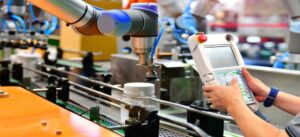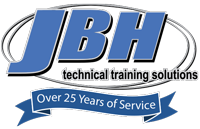Intelitek is at the forefront of Industry 4.0 education for industrial maintenance programs – this blog highlights the significance of Intelitek-like programs in Education.
CTE Educators have had their hands full responding to unprecedented challenges during the last few years. While striving to continue high-quality teaching and learning during the pandemic, leaders have grappled with how to deliver instruction to students remotely, make sure every student could participate remotely, reopen facilities safely, and ensure the health and well-being of students and staff.
In focusing on meeting these challenges, schools and colleges might have missed the dramatic changes occurring within industry at the same time. Although artificial intelligence and automation were already transforming business processes across all sectors before the pandemic, COVID-19 has greatly accelerated the pace of change in manufacturing and industry.
Experts have referred to these changes as the Fourth Industrial Revolution, or Industry 4.0. The First Industrial Revolution introduced steam power to mechanize production. The Second pioneered the production line to create mass production. The Third used computers to automate production. Now, Industry 4.0 is building on the advancements of the Third Industrial Revolution by leveraging the internet, AI, and the power of smart networks to bring automation to a whole new level.
Industry 4.0 explained
In Industry 4.0, machines, devices, sensors, and people connect and communicate with each other via the Internet of Things (IoT). Advanced software and data analytics provide real-time analysis and visualization of the health and status of systems. Artificial Intelligence (AI) allows systems to make decisions on their own and perform tasks as autonomously as possible.
These advancements have taken a big leap forward during the last few years, which has given manufacturers and supply chain companies a compelling reason to invest in new technologies. The pandemic has accelerated this change. Because of COVID-19 and its effects on the supply chain, manufacturing has undergone about five years’ worth of innovation in just an 18-month span, Forbes reports.
As more services and business processes have been transformed through smart automation, this rapid shift has created a demand for more highly skilled workers who can support new digital innovation, interpret data, program machines, and develop software. In fact, industry leaders are warning of a growing “digital skills gap” that threatens to stifle innovation if it isn’t closed soon. According to a report from the RAND Corporation, 54 percent of large companies say a lack of digital talent has hurt their competitive advantage—and the world’s major economies could lose up to $11.5 trillion in growth over the next six years if the skills gap isn’t addressed.
Implications for schools
These developments have significant implications for the future of CTE education and the skills that students should be learning. Here are four ways that schools must change in response to current industry needs.
Education leaders need to rethink their messaging to students and families.
Contrary to popular belief, the U.S. manufacturing industry is actually growing—and manufacturing output surged to a 37-year high last year. When U.S. factories offshored jobs, it was because they wanted inexpensive, manual labor. But as manufacturing processes have become more automated, companies today need highly skilled workers who can operate and maintain robots and machines, interpret increasingly sophisticated information, and solve problems on the shop floor in real time. By 2030, the U.S. will need an estimated 2.1 million more manufacturing employees to fill the demand.
Educational leaders can help businesses close this gap and give students a viable alternative to college by raising awareness of manufacturing as a promising career path in these mid-market roles. With millions of well-paying jobs available in this field over the next decade, students don’t have to choose between going to college or working in the service industry.
All students should graduate with basic technology and data literacy skills.
The changes brought on by Industry 4.0 mean that the jobs of the future will require at least some basic technology and data literacy skills, even in fields that were considered low-skilled before.
The RAND Corporation report defined a broad range of digital skills that employers are looking for today, including data processing and management, digital communication, and collaboration, and using technology tools for problem solving and critical thinking.
For example, advanced smart sensors now monitor and report on real-time status information from equipment in an industrial process and use trends or anomalies to identify potential failures before they happen, prompting pre-emptory service in order to avoid costly downtime. Factory workers must know how to monitor this information over cloud-based networks, understand changes in the data, and interpret what the information might mean. The technicians who once walked around the factory floor with a bottle of oil to deliver proactive maintenance now carry a tablet computer instead.
Students also need to learn more advanced technology skills.
Basic digital literacy skills are a starting point, but there is also a growing demand for employees with high-level technology skills to support, install, update and tweak machines in the smart factory. Industry in 2022 is all about integration of smart devices, robotics, and machines into a coherent automated process. Operators need to have core education of the machines, but also the ability to understand and support the integration of systems, communications between systems and operation of systems in the digital, internet enabled ecosystem of smart factories.
Industry 4.0 highlights some of these core advanced technologies like Internet of Things (IoT), Big Data, Industrial communications, Cloud computing, and cyber-security as these are new internet enabled technologies that need to be part of the employee’s toolkit in order to swim in the industry 4.0 waters.
Work with industry partners to develop support for your program.
Industry 4.0 is rapidly transforming key workforce needs and the skills that are required for success. Educational leaders must recognize these changes and work with local industry partners to redesign curricula to align with these developments more effectively and to line up with the needs of their industry partners. Industry collaboration will help faculty not only ensure their students are best trained for local jobs but will also encourage local employers to send their workforce for retraining or upskilling. Local industry also wield influence when the school administration and local government allocate budgets for the school. Industry/education collaboration has far-reaching implications not just for students, but for economic growth and development.
Summary
Vocational training for manufacturing has changed to CTE for Smart Factories and Industry 4.0. Technical educations schools need to process this change and prepare properly to update their programs to support the changes.
For more about setting up industry 4.0 programs in your school, contact Intelitek.
























